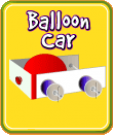
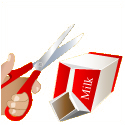

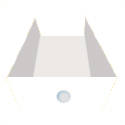
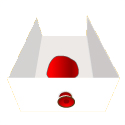
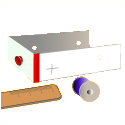
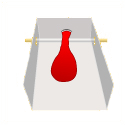
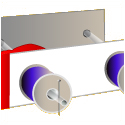
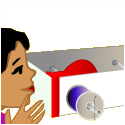
Experiment Category:
Objective:
What You Need:
- Half-Gallon Milk Carton
- Balloon
- 2 Drinking Straws
- 4 Spools
- 4 Straight Pins (length must be shorter than spools’ diameter)
- Sharp Scissors
- Ruler
- Pen
To Do and Observe:
1. Wash out your carton and cut off the top. The milk carton will be the body of your vehicle.
2. Cut carton it in half the long way.
3. Cut a small hole in the middle of one of the short sides of the carton. This hole should be the same diameter as the neck of the balloon. Start with a small hole. The fit must be precise - if the hole is too big or too small, the flow of air won’t create enough force to move the car.
4. Pull the end of the balloon through the hole, keeping the body of the balloon inside the carton. If the neck of the balloon is squeezed, enlarge the hole. Repeat until the fit is snug, but not tight. Air flow should not be restricted.
5. Mark the spots on the sides of the carton where you will cut holes for the axels. Use a ruler to make sure the holes on opposite sides of the carton will match up. Use the spools to measure and make sure the axel holes are at a height that will allow the spool-wheels to touch the rolling surface and lift the body off of the surface.
6. Cut holes for axels and push straws through the holes.
7. Slide spools on to the straws and poke pins through the straws to keep the spools on. Adjust the pins as needed until the wheels spin freely.
NOTE: For younger children, please have a parent or other adult help in this step.
8. Finally, blow up the balloon – don’t tie the end – and let your car
What's Going On:
This activity allows you to explore a range of science topics including Newton’s Third Law, simple machines and friction. Newton’s Third Law states that for every action there is an equal and opposite reaction. If you let go of a balloon filled with air, what happens? The balloon flies around somewhat randomly as the air escapes. As the balloon contracts it forces the out of its opening. Air has mass, it is made of molecules. The air molecules that are pushed out of the balloon push against the molecules in the atmosphere creating a reaction force called thrust that acts on the balloon. Thrust acts on the balloon with equal force in the opposite direction as the air that is squeezed out. In this activity, because the balloon is attached to the vehicle, the balloon stays put, but thrust causes the car to move.
Without the spools on the balloon car, do you think the car would move? It probably would, but not as far. That is because much more of the bottom surface of the car would make contact with the surface that it is moving on. This increased amount of contact would lead to lots of friction, the force of two surfaces in rubbing against each other. By adding the spools to the car, we decrease the amount of friction because only the spools – acting as wheels - are making contact with the surface, and they are spinning rather than rubbing. The wheel and axle are one of the six types of simple machines, which are tools that allow us to do a certain amount of work (like use air to push a car a certain distance) by applying a smaller force than would be needed without the simple machine. We find examples of simple machines around us all the time. Some examples of a wheel and axle that help us every day are doorknobs and the gears in a clock. Can you think of some others?
Parent/Teacher Tips:
For Younger Children
Before the children attach the wheels and axles, have them blow up the balloons and let their cars go. How far does the car travel? Does it go very fast? Have the children hypothesize as to what modifications might make the car travel farther and faster.
For Older Children
Have the children test their balloon cars on different surfaces. Ask them to observe or measure how far and how fast the car travels on a carpet. Then have the children do the same thing on a smooth, flat table. Were there any differences in the cars’ speed or distance traveled on the different surfaces? On the textured surface of the carpet there will be more friction and the balloon car should not be able to travel as fast or as far as it will on a smooth surface. The children can make hypotheses about additional types of surfaces and other variables, perform tests and observe the results.

Comments
Its just interesting